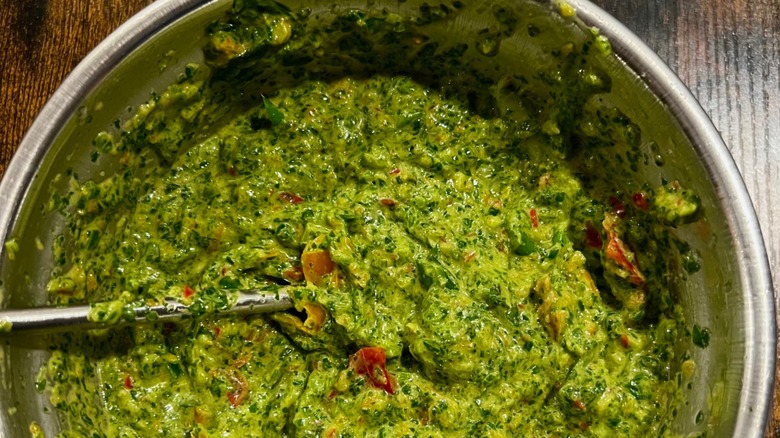Caribbean cuisine is known for bold flavors shaped by African, European, and Asian influences. It’s also known for its incredible culinary diversity — each island has nuances that differentiate one’s cuisine from the other, arising from its history of colonization, migration, and international trade. A common link among the different islands’ traditions, however, is green seasoning, a striking blend of herbs, vegetables, and spices that appears in a variety of forms in Caribbean cooking.
Green seasoning is most often made with a combination of garlic, parsley, onion, celery, hot peppers, and culantro, also known as chadon beni or Mexican coriander. The type of peppers used in traditional green seasoning depends on what’s geographically available; habaneros, scotch bonnets, and Guyanese wiri wiri are all popular choices based on where they’re most abundant. The ingredients are pulverized together to create a blend that’s fresh, zesty, spicy, pungent, and punchy, all at the same time.
The versatile mix is often slathered on as a marinade for grilled meats, and its complex flavor profile can even be used to improve store-bought barbecue sauces. It’s also used to bring depth and vibrance to broths, such as the kind Trinidadian corn on the cob is boiled in. You can find it being mixed into curry sauces, lightly spread onto sandwich bread, and topped over rice and vegetables. The complexity of green seasoning leaves a lot of room for experimentation, especially since each region in the Caribbean has its own take on it.
Regional variations of Caribbean green seasoning
The flavors of the Caribbean have been influenced by centuries of colonization, and green seasoning has evolved in different areas based on which foreign powers shaped their history. In Spanish-colonized islands, the seasoning is more commonly known as sofrito, which is recognized as a foundational spice base for Cuban food. This variation of green seasoning adds green bell peppers to the mix and can feature ingredients that align with the Spanish palate, such as red tomatoes, wine, and chorizo. Oregano, considered by many to be an essential ingredient for great Cuban food, can also be found in Cuban sofrito recipes.
Haitian cuisine, on the other hand, is heavily influenced by the French as well as the culinary traditions of enslaved Africans. Recipes for epis, Haiti’s take on green seasoning, usually include olive oil and a souring agent such as lime or vinegar. Scotch bonnet peppers, a very popular ingredient in West African cuisine, also feature in epis.
The British Empire introduced a wide variety of ingredients from across the world to Trinidad, and it shows in the Trinidadian version of green seasoning. It often features culantro from South America, scallions from Asia, and thyme from the Mediterranean. As with every other variant in the region, these influences give Trinidadian green seasoning distinct layers in its flavor profile, with the scallions and thyme bringing a slight sweetness to the blend.






